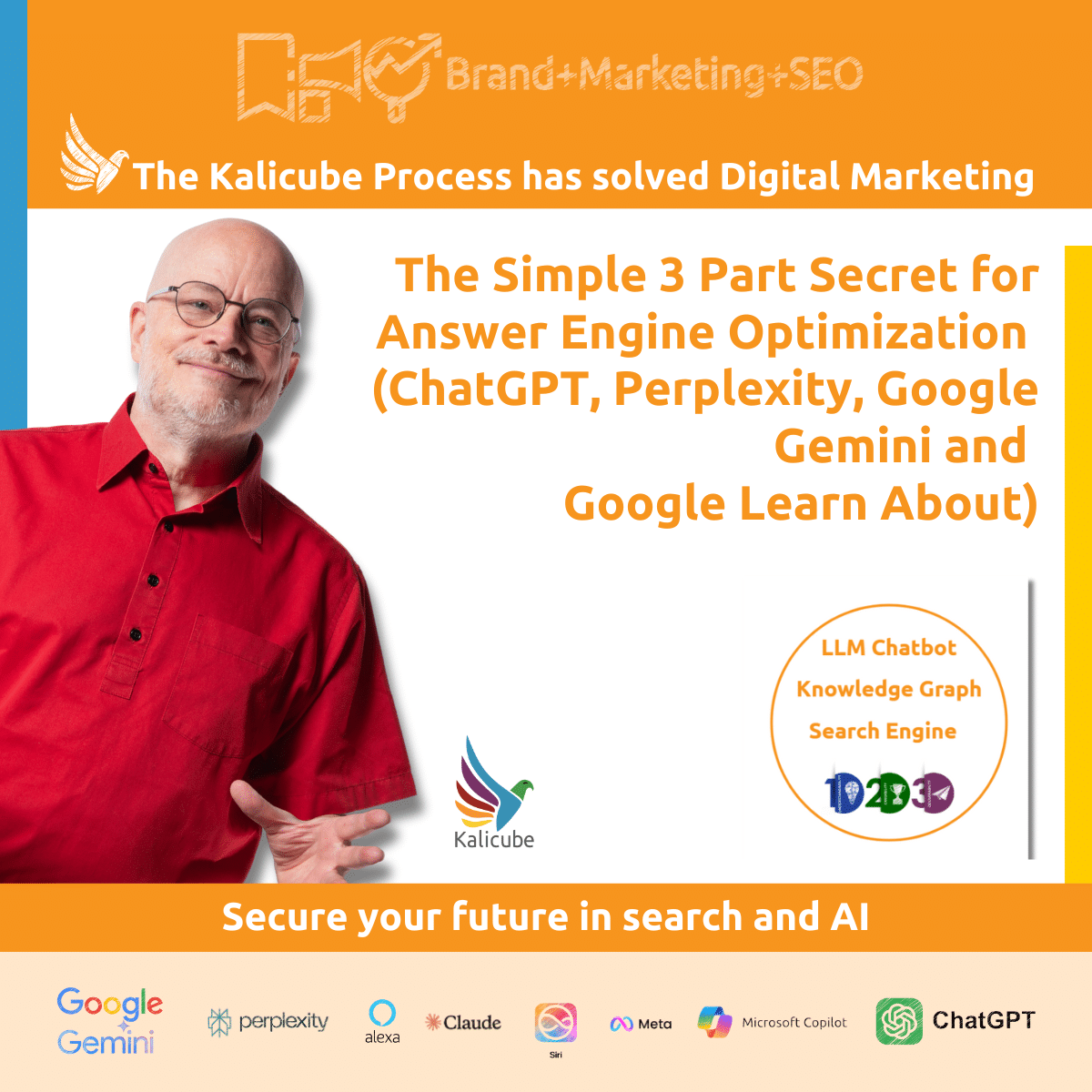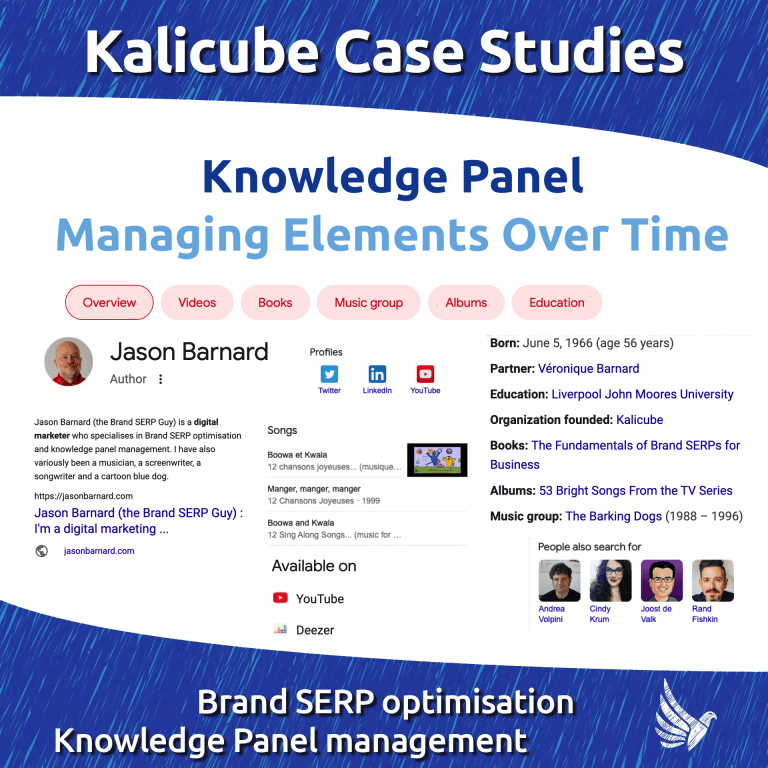The Algorithmic Trinity – the Simple 3 Part Secret for Generative Engine Optimization

All Answer Engines / AI Assistants / Generative Engines are built using just three technologies
- LLM chatbot
- Knowledge Graph
- Search Engine
All three technologies use the same data source: the web.
These technologies are the “Algorithmic Trinity”.
- LLM chatbot
- Knowledge Graph
- Search Engine
Kalicube’s Simple (not so) Secret Sauce
If you can take full control of your digital footprint for your company (or a person), you win the game.
The Kalicube Process™ gives you control of your digital footprint and amplifies all the signals. Exactly what works for Answer Engines.
Some Examples of How Generative Engines / AI Assistive Engines use LLM, Search Results and Knowledge Graphs
The “mix” of the three technologies is the key differentiator. Each engine uses different doses of LLM, Search Results and Knowledge Graphs.
You’ll quickly realise that control of your web-wide digital footprint is the key, whatever flavour of AI / Assistive / Answer Engine you are optimizing for (Google Learn About, ChatGPT, Perplexity, Bing… and even Google Search).
Some examples – percentages are not to be taken too literally, they are to provide a comparison
Google Search
Majoritarily search, with Knowledge Graph (the Knowledge Panel, Entity Boxes etc), and a optional LLM (AI Overviews is search summarized by an LLM (Gemini) + some fact checking using the Knowledge Graph.
|
Technology |
Google Search Technology Blend Percentage |
|---|---|
|
LLM ChatBot |
15% |
|
Knowledge Graph |
25% |
|
Search results |
60% |
Bing Search
Search, optional Generative Search (based on their LLM) integrated into the results plus their knowledge graph (the Knowledge Panel).
|
Technology |
Bing Search Technology Blend Percentage |
|---|---|
|
LLM ChatBot |
30% |
|
Knowledge Graph |
15% |
|
Search results |
55% |
ChatGPT
Majoritarily LLM ,with some search (a lot of search with WebPilot), and little (or no) knowledge graph fact checking.
|
Technology |
ChatGPT Technology Blend Percentage |
|---|---|
|
LLM ChatBot |
65% |
|
Knowledge Graph |
0% |
|
Search results |
35% |
Perplexity
Search results summarized by an LLM. And with Deep Search it adds a reasoning LLM and some knowledge fact checking.
|
Technology |
Perplexity Technology Blend Percentage |
|---|---|
|
LLM ChatBot |
50% |
|
Knowledge Graph |
0% |
|
Search results |
50% |
Google AI Mode
Search results summarized by an LLM with a little fact checking using the Knowledge Graph.
|
Technology |
Google AI Mode Technology Blend Percentage |
|---|---|
|
LLM ChatBot |
40% |
|
Knowledge Graph |
10% |
|
Search results |
50% |
Google Learn About
Search results summarized by an LLM with some fact checking and additional information provided by the Knowledge Graph. Importantly, on the left they offer additional context and research opportunities using filter pills (similar to those we have seen in Knowledge Panels for years) provided by a mix of LLM and the Knowledge Graph.
|
Technology |
Google Learn About Technology Blend Percentage |
|---|---|
|
LLM ChatBot |
40% |
|
Knowledge Graph |
20% |
|
Search results |
40% |
How the Algorithmic Trinity Defines the Future of Generative Engine Optimization
Within the Algorithmic Trinity: there is a foundational interplay between the Knowledge Graph (understanding), Large Language Models (synthesis), and the traditional web index (retrieval).
Each component serves as a critical pillar for how AI-driven platforms understand, interpret, and deliver information about you or your brand. The Knowledge Graph provides structured factual accuracy, grounding responses in verifiable data. Large Language Models contribute sophisticated synthesis, enabling conversational and contextually rich interactions - often leveraging their internal “knowledge” base accumulated during training, independent of external retrieval. Lastly, the traditional web index ensures comprehensive retrieval of additional, timely content when the LLM’s internal knowledge or the Knowledge Graph alone isn’t sufficient. Mastery of Generative Engine Optimization demands proactive management across all three components, ensuring algorithms see your brand as the clearest, most credible, and most deliverable answer - especially critical as LLMs increasingly rely on their intrinsic understanding and only selectively access external retrieval resources.
The Kalicube Process for Generative Engine Optimization
The Kalicube Process is a Universal Strategy for Generative Engine Optimization (micro Answer Engine Optimization) because it amplifies the effect of your entire web presence and optimizses for all three technologies all Answer Engines use: search results, LLM chatbots, knowledge graphs.
You can DIY The Kalicube Process™ >>
The Kalicube Process Implemented with You by our Digital Brand Engineers
We implement The Kalicube Process with surgical precision using our proprietary technology, Kalicube Pro, backed by 3 Billion data points. Our tech organises the digital footprint, and then holds all the pieces together in an incredibly tight ball in a format that all three (search, knowledge graphs and LLM chatbots) can easily digest.
The Kalicube Process™ Done With You for a Business >>
The Kalicube Process™ Done With You for a Person >>
Further reading about the Algorithmic Trinity
Within the Algorithmic Trinity, there is a foundational interplay between the Knowledge Graph (understanding), Large Language Models (synthesis), and the traditional web index (retrieval). These three pillars govern how AI-driven engines-such as ChatGPT, Google’s Gemini, Bing’s CoPilot, and Perplexity-interpret and present information about brands and individuals. The collective influence of the Algorithmic Trinity is growing but one element, the web index (once the cornerstone of digital visibility), is losing its primacy.






